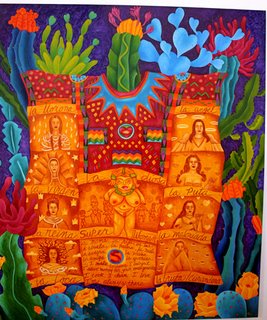It’s almost incredible that chicano art shows keep getting better and better. An excited crowd is its own reward; energized by ambience, conversations flow among strangers sharing delighted moments of inspiration. In such moments, crowd and art fuse into the same thing, culture. Every show brings new talents to the walls, but for me, seeing the maturation of talent in new work by familiar artists offers the greater pleasure.
So it was at the opening reception for Chicano: Pronouncing Diversity, in Los Angeles’ Eagle Rock Cultural Arts Center. An encouraging display by a new generation of artists and a core of veteranas and veteranos from the old days. Holding it all together the familiar materials and attitudes of chicanismo.
 At one point during the exhibit, I was leaning against a pillar taking candid shots of Vibiana Aparacio-Chamberlin speaking animatedly with Serge Hernandez about Pola Lopez’ irreverent piece combining loteria cards and la Virgen. Out of the blue, I remembered Salvador Plasencia saying he’s glad to be published outside the chicano mainstream.” And here’s Pola placing her work squarely in the heart of that mainstream.
At one point during the exhibit, I was leaning against a pillar taking candid shots of Vibiana Aparacio-Chamberlin speaking animatedly with Serge Hernandez about Pola Lopez’ irreverent piece combining loteria cards and la Virgen. Out of the blue, I remembered Salvador Plasencia saying he’s glad to be published outside the chicano mainstream.” And here’s Pola placing her work squarely in the heart of that mainstream.I asked Magu, who curated the exhibit, what qualifies a piece for the show? Not what makes the work “good,” but what makes it “chicano.” I got the answer the question deserves: go inside and have a look.
The excitement of the moment begins at the door with Raoul De La Sota’s painting of cactus pencas. Hugely magnified and rendered in fanciful warm colors, the canvas evokes Rousseau’s “Magical Kingdom”. Turing left into the main gallery, the visitor will be welcomed by the curator, who will nudge the visitor to take in the vendor’s cart, and photographer Oscar Castillo’s tribute to Frida.
Joe Bravo and Serge Hernandez hung out near the door, looking for old friends as Magu invites the new arrivals to grab a plate for the buffet. Later, Oscar will tell Diane Hernandez she is the subject of the first multiple image Oscar printed, back at Cal State Northridge in the 70s.
A perennial chicana chicano theme, la Virgen de Guadalupe’s familiar cloak covers the muscled black of a Pacoima loyalist. The orthography is a high level script echoing grafitti art.
Pola Lopez' large canvas offers a delight of color. Eight virgins and one diosa decorate a luciously red-orange huipil. A phallic cactus thrusts out of the collar.
 It’s interesting to compare Lopez’ manifestations of the virgin with Sculptor Robert Graham’s bronze door to Los Angeles’ new cathedral using a multitude of virgins in much the same manner.
It’s interesting to compare Lopez’ manifestations of the virgin with Sculptor Robert Graham’s bronze door to Los Angeles’ new cathedral using a multitude of virgins in much the same manner.Conjunto Los Pochos had the crowd tapping their toes. Left of the stage, Joe Bravo tortilla art featuring a sabana-sized tortilla de harina. Behind the conjunto, holding center focus of everyone’s eyes, a brilliant mural by Martin Charlot featuring a young Arnold Schwartzeneggar lower right, Magu, lower left. Right of the stage is an exaggerated portrait by Neri Lemus of a boy in a striped t-shirt and ear-flapped hunter’s cap.
A little boy gets so caught up in the joyous music that the accordion player hangs the precious instrument on the tyke, who pulls the bellows and sounds his first note!
Sculptor Armando Baeza is a WWII veteran. His small and medium sized bronzes attract admirers wherever Baeza shows his work.
 The show features a handful of medium sized work. The free-standing bases are themselves beautiful sculpture. A photograph is not enough when an admirer falls in love with Apache Dancer, or Emerging Power.
The show features a handful of medium sized work. The free-standing bases are themselves beautiful sculpture. A photograph is not enough when an admirer falls in love with Apache Dancer, or Emerging Power.Mario Triillo 's usual medium is polaroid photo transfer. Taking up the Diversity theme, Trillo builds a shrine to upward mobility.
 The bottom rung of the ladder features a beat up old huarache. The second rung a clean white Nike sneaker. The top rung sports a spit-shined black lace-up shoe. At the top of the ladder the U.S. flag. The umbrella protecting the ladder sports corporate logos of Pepi, McDonalds, Union Oil Co.
The bottom rung of the ladder features a beat up old huarache. The second rung a clean white Nike sneaker. The top rung sports a spit-shined black lace-up shoe. At the top of the ladder the U.S. flag. The umbrella protecting the ladder sports corporate logos of Pepi, McDonalds, Union Oil Co.As Magu says, you really have to be there, see the art, feel the energy. Just enjoy. Don't ask, "What makes this 'Chicano' art?" Instead, share your views on what you see in the work that qualifies your assessment. Please leave your comments.
Until next week, that's Tuesday, Nine One Two.
mvs
Thanks for your comments on the "Chicano : Pronouncing Diversity" art exhibition. It is always good to get a good write up for a good quality art exhibition. The art work will always be great but it is the lack write ups that unable Chicano Art from being recognized. I recently visited the Banksy art exhibition this weekend which had so much media and news reports. Honestly its the media that created the hype on work that I had seen before. We need more writers to tell the truth.
ReplyDeletePeter E Carrillo